William Highett: Business Man and Politician
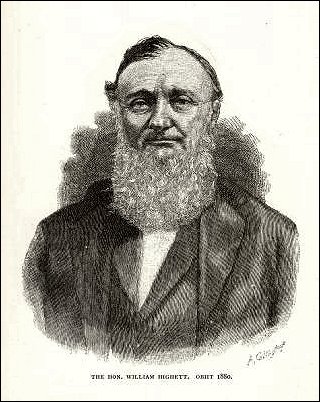
William Highett, c1875.
When the railway line between Caulfield and Mordialloc was opened on December 19, 1881, eight stations were established along its length. The name of the station between Cheltenham and South Brighton (later renamed Moorabbin) reflected its location on Highett’s Road. At that time this road, according to Box, was just a cattle track leading to William Highett’s property from Arthur’s Seat Road but the name was a logical choice “as the road was the only sign of human habitation at that point.” [1]. The property was only one of several owned by William Highett, a bachelor, business man, politician, and land speculator.
William Highett, born in Weymouth in the county of Dorset, England in 1807, was the son of Joseph Highett and his wife Elizabeth (nee Harding). He travelled to Van Diemen’s Land with his brother John, arriving in Hobart Town in February 1830. With a combined capital of £507 and highly respectable testimonials they were granted 500 acres of land at George Town. Later they acquired extensive land holdings at Launceston and Campbell Town; properties which John Highett managed. [2]
Two years after his arrival in Hobart William was appointed as the accountant of the Launceston branch of the Van Diemen’s Land Bank. [3] In January 1835 he joined the Tarmar Bank Company as cashier, remaining there until he accepted the position of manager of the Union Bank of Australia in Melbourne in 1838. The Union Bank had taken over the Tamar Bank in Launceston that same year. [4]
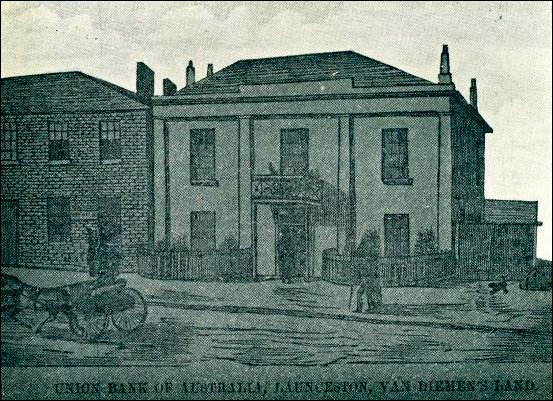
Union Bank of Australia, Launceston, formerly the Tamar Bank.
The Melbourne branch of the Union Bank which Highett joined began in a single storey brick building on the corner of Queen Street and Flinders Lane but with the growth of business a second storey was added the next year. With continuing success the bank bought land costing £30 a foot on the south east corner of Collins and Queen streets. There in 1842 Donovan & Crosbie erected an impressive new bank building constructed entirely of stone and designed by George Mac Lagan.[5] It was in that same year, taking leave of absence, Highett travelled to Europe but while in England resigned from his position in the bank. However on his return to Melbourne in 1845 he was reinstated as a local director of the Union Bank, remaining in this position for a number of years. [6]
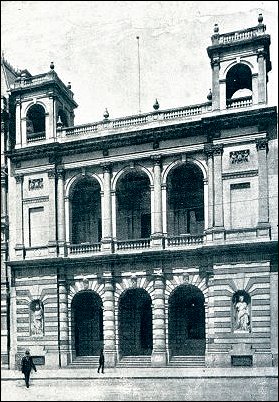
Union Bank of Australia, Collins Street, Melbourne c1900.
William Highett became deeply involved with the growth of business and commercial developments in Melbourne, although not all his ventures were successful. He was one of the founders and a director of the Bank of Victoria which was established by Melbourne businessmen. They was concern that all the dividends from their successful activities were going to Sydney or London, consequently, after some initial hesitancy on the part of some investors, the Bank of Victoria was launched. Highett, as Deputy Chairman, joined Henry Miller, William Nicholson, W F Splatt, W H Tuckett and Alexander Wilson on the first board of directors when the bank commenced trading in January 1853. [7]
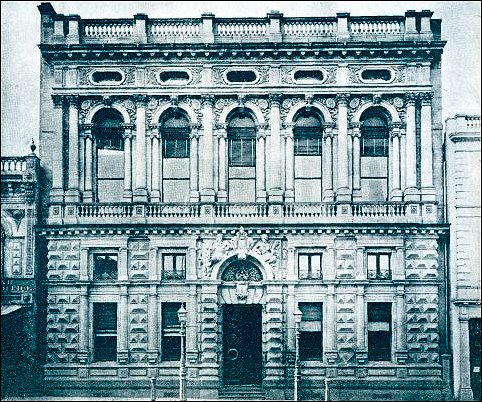
Bank of Victoria, Collins Street, Melbourne.
The Victoria Fire and Marine Insurance Company, inaugurated in 1849, was another company in which Highett played an early role. In addition, he held many shares in the Hobson Bay Railway Company, he helped to found the Melbourne Mechanics’ Institute, and was an early member and trustee of the Melbourne Club. [Sutherland] He was company treasurer of the ill-fated Melbourne and Suburban Railway Company in that was forced to go into liquidation in 1857, and a steward of the Brighton Racing Club for several years in the late eighteen forties. [8] The latter task may have been more of a sporting interest rather than a business one.
In April 1840 William Highett was amongst a number of prominent Melbourne businessmen, including Jonathan Binns Were, William Langhorne and Godfrey Howitt, in establishing the Melbourne Auction Company. The aim of this company was to afford sufficient security and increased facilities to parties having property to sell. But it soon met its demise. The Governor of New South Wales, Sir G Gipps, refused to sanction a private bill in the Legislature of New South Wales enabling the managing director of the company to sue and be sued. Without this power the company could not continue. [9]
Early in 1850 there were reports of coal being discovered in Western Port. A previous report had led nowhere but interest on this occasion was strong enough for a public meeting to be called at the Royal Hotel on June 4. William Highett was one of the speakers. It was resolved at the meeting that before a company was created a ‘Preliminary Expense Fund’ should be established by subscription; the money gained to be used to fund the initial exploratory work. If the findings were favourable then a company would be formed. £500 of the desired £700 for the fund was raised at the meeting. William Highett was elected to a committee of eleven established to direct and supervise an efficient search party. According to Garryowen, “The exploring party went, and so did the Preliminary Fund, and though the former returned, the latter was lost. It all ended in fizzle.” [10]…
In addition to his business activities William Highett was also involved in the political life of the colony. For some time he was a non-official nominee member in the Legislative Council, and on the introduction of responsible Government in 1856 he stood as a candidate to represent the Eastern Province in the Legislative Council. He was defeated. Highett’s opponents persuaded the local publicans to refuse him a room and to inform their thirsty customers that Highett was weak in the head. [11] Whether this action was a major cause of his defeat is not known. However, when a new election was called following the unseating of William Kaye, Highett was victorious after a close contest with Dr Gemmell. [12] He was subsequently re-elected, unopposed on two separate occasions, finally retiring in 1880.
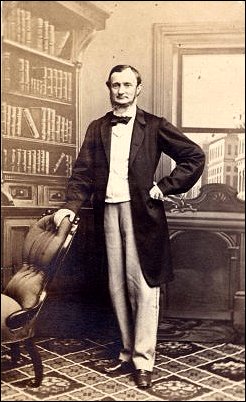
William Highett as a Member of the Legislative Council. Reproduced with the permission of the library Committee of the Parliament of Victoria.
William Highett was a speaker at a meeting held on October 12, 1843, at the Royal Exchange Hotel to discuss the poor prices of farm produce and to seek a remedy. Three resolutions were passed. One affirmed the necessity for protecting the agriculturists by imposing “a duty upon grain, not the product of a British settlement, sufficiently high to render farming profitable, but not too high for the consumer.” The second resolution proposed that legitimate farmers, the proprietors or occupiers of purchased land should be protected against competition from “squatters on Crown lands whose tenure was a mere depasturing licence.” The third resolution agreed to was that distillation should only be permitted from grain. [13] William Highett was elected to a committee formed to promote the intentions of the meeting.
Besides the ‘Protection’ cause, Highett was active in the separation movement working to gain independence for the Port Phillip Bay District from Sydney. He supported state aid, national schools, as well as the extension and opening of crown land with moderate compensation for squatters. In all he was considered to be a conservative but industrious member of the Legislative Council. At the time of his death, Sir C Sladen, a colleague in the Council, described William Highett as an “indefatigable, attentive, and courteous member.” [14]
William Highett was an early owner of land in Melbourne, as in August 1, 1839 he purchased Portion 37, in the Parish of Jika Jika at Richmond for £784-0-0. [15] On July 22, 1847 Highett paid £240 for allotment 19 in Section 28, on the corner of Elizabeth Street and Little Bourke Street. [16] A third purchase, Portion 45, was made in Jika Jika in May 1851. The following year Highett gained at auction Portions 10 and 17, in the Parish of Moorabbin and thereby added 180 acres to his land holdings. Portion 10 was adjacent and to the north of Josiah Holloway’s Gipsy Village sub division in an area that was later part of the Shire of Moorabbin. It was to this land that the track known as Highett’s Road ran. The other portion was further to the north on what is today called Bluff Road. There was another thirty acres of land in the Parish of Moorabbin, Portion 6, that Highett purchased with J Cowie. By the late 1870s Highett held 6117 acres in the Parish of Moorabbin valued at £15,292 in addition to land at Richmond and other suburban locations . [17] Highett also had land in other areas of Melbourne including the district that was to become Newport. There he purchased eighty acres with F D Wickham paying £302 for land that had been relinquished by the Crown Commissioner, G S Airey. [18]
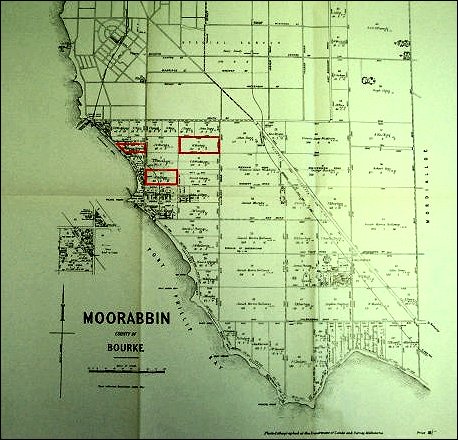
Land owned by William Highett in the Parish of Moorabbin.
It was on the Richmond property that William Highett built his home with a frontage to Erin Street and named it ‘Yalcowinna’. The residence was described in a newspaper advertisement as “a palatial residence finished with artistic skill where no expense was spared with its appointments.” [19] The ground floor contained a dining room 28 x 16ft, a ballroom 45 x 23ft, a billiard room 24 x 23ft, lavatory 14 x 8ft; breakfast room 16 x 14ft, one bedroom 16 x 14ft and two servants’ rooms. The first floor had a drawing room, 23 x 16ft, and five bedrooms of varying sizes. The outbuildings comprised a four-stall stable, three looseboxes, two coachhouses, a man’s room, a hayloft and wood and coal sheds. All these buildings were set in grounds that were “very tastefully laid out” including a lawn tennis court and an asphalt tennis court, 100 x 80 ft. in size.
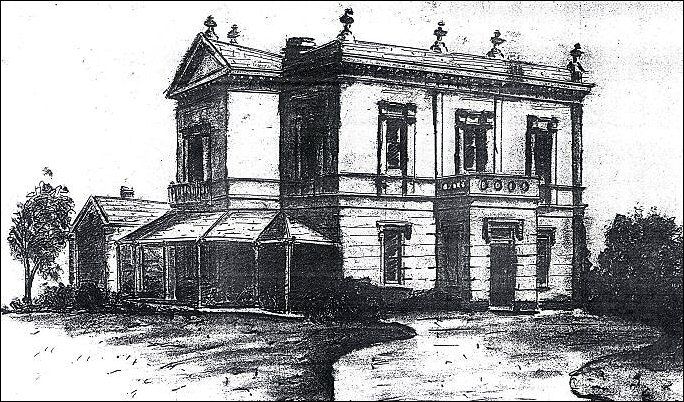
Yalcowinna, Richmond.
In 1872 the land at Richmond was sub-divided and offered for sale by auction. Twenty three blocks of land were made available in Hoddle Street, Erin Street, and Highett Street, with the terms of sale being twenty five percent cash deposit with the balance being paid in one, two, or three years but bearing interest at the rate of 7 percent per annum, payable quarterly or half yearly. The frontages of the blocks varied from 41ft to 66 feet, each with a depth of 132 ft. [20] Further land in ‘Highett’s Paddock’ in Bridge Road and Erin Street was offered for sale in 1883 after William Highett’s death. [21]
William Highett never married and at his death left no will. A nephew, John Moore Highett, a gentleman of Erin Street, signed a witnessed statement for the Supreme Court of Victoria concerning the property William held at the time of his death. This included the thirteen room ‘Yalcowinna’ on land fenced partly with iron fencing and partly with paling fencing. Half the land surrounding ‘Yalcowinna’ was a paddock while the remainder consisted of garden and shrubbery. The other land at Richmond owned by Highett, bound by Hoddle Street, Bridge Road, Erin Street and Dodgshun’s property had a capital value of £16,456. [22]
At the time of Highett’s death he owned two other properties. One was referred to as the ‘Maindample Park Estate’ [23] and the other a shop with premises in Spring Street, Melbourne. The estate was subdivided into eight paddocks with a homestead of eight rooms built of slabs with bark roof, noted as being old and rotten. There was a shed and stable built of slabs and two dams together with a set of cattle yards for branding. In his affidavit to the Supreme Court of Victoria, John Moore Highett wrote, “The number of cattle on the farm consisted of six hundred and fifty head of cattle including one hundred and forty calves under six months old and ten horses.” Their value was given as one thousand nine hundred and thirty three pounds. The Spring Street property had a frontage of 27 feet 9 inches and consisted of a shop and back premises built of brick with an iron roof. It was used as a venetian blind factory. The buildings were beyond repair, being very old and dilapidated. [24]
William Highett when 72 years of age died at Yalcowinna on November 29, 1880 from inflammation of the kidneys and lungs. Two days after his death he was buried in the Melbourne General Cemetery. [25]
Footnotes
- Box, G., Paper on the History of CSIRO’s Division of Building, Construction and Engineering, c1990.
- Pike, Douglas (Ed), Australian Dictionary of Biography, Vol 4, 1851-1890, 1972.
- Sutherland, A., Victoria and Its Metropolis, 1888. page 479 – Note in Cyclopedia of Tasmania, 1900, Vol II page 71 John Highett is listed as the accountant and not his brother William.
- Smith, James, (Ed) The Cyclopedia of Victoria, 1903.
- Cannon, Michael, Melbourne After the Gold Rush, 1993, page 230.
- Sutherland, A., Victoria and Its Metropolis, 1888 page 479.
- Smith, James. (Ed), The Cyclopedia of Victoria, 1903.
- Cannon, M., Melbourne After the Gold Rush, 1993 page 178; Bate, W. A., History of Brighton, 1983 page 84.
- Garryowen, (E Finn), Chronicles of Early Melbourne, 1888.
- Garryown, Ibid.
- Quaife, G.R., The Victory of the Ballot in 1856, The Victorian Historical Magazine, August 1967.
- Sutherland, A. Victoria and Its Metropolis, 1888.
- Garryowen, (E Finn), Chronicles of Early Melbourne, 1888, Chapter XLI, page 555.
- Hansard, Parliament of Victoria, Legislative Council, November 30, 1880, page 922.
- Historical Records of Victoria Vol 6 page 402 The Crown, the Land and the Squatter 1835-1840.
- McIlroy, W., Melbourne’s Land Sales, The Victorian Historical Magazine, Volume 63, November 1937.
- Hone, J. Ann, Australian Dictionary of Biography Volume 4, page 390.
- Cannon, M., Old Melbourne Town: Before the Gold Rush, 1991 page 48. Note F D Wickham also made extensive purchases of land at auction in 1852 in the Parish of Moorabbin.
- Richmond Australian, November 3, 1883.
- Richmond Australian, May 4, 1872.
- Richmond Australian, November 3, 1883.
- Affidavit of John Moore Highett to Supreme Court of Victoria, April 13, 1881.
- Maindample is adjacent to Lake Eildon, south of Benalla and to the west of Mansfield about 120km north-east of Melbourne. In 1861 it had a population of 41 people.
- Affidavit of John Moore Highett to Supreme Court of Victoria, April 13, 1881.
- Registry of Births Deaths & Marriages, Melbourne.
